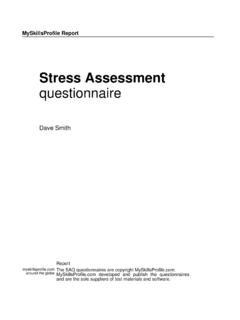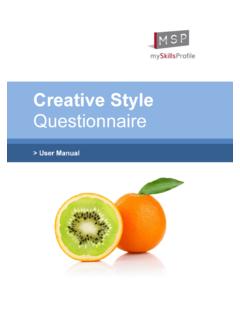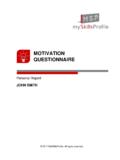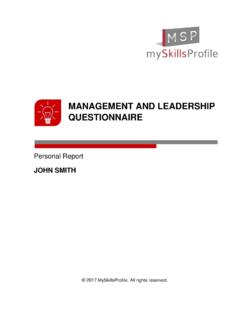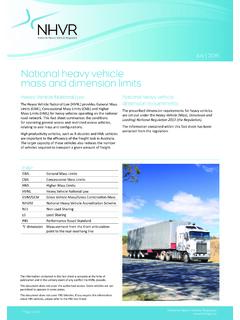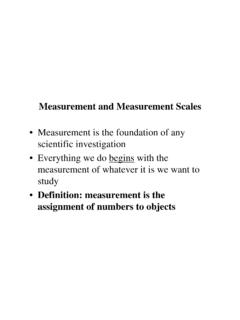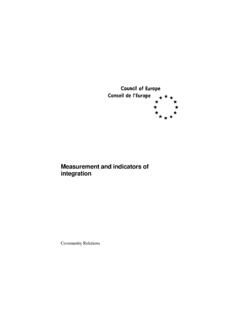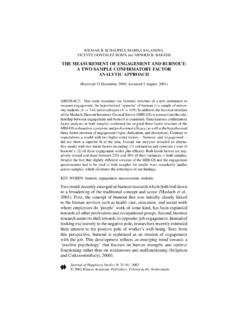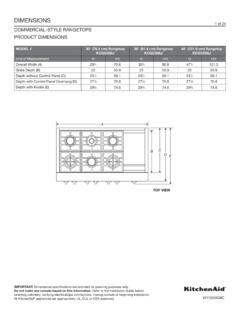Transcription of MQ Motivation Questionnaire User Manual - MySkillsProfile
1 Motivation Questionnaire > User Manual Page | 2 Copyright 2014, Limited. MQ is a trademark of Limited. All rights reserved. No part of this publication may be reproduced or distributed in any form or by any means or stored in a database or retrieval system without the prior written permission of Limited. Page | 3 Contents 1. Introduction _____ 4 Purpose of MQ _____ 4 What the MQ Measures _____ 5 Development of the MQ _____ 5 Model of Work Motivation _____ 7 Motivation and Performance _____ 8 2. Applications and Administration _____ 9 Applications _____ 9 Administration_____ 9 Norming _____ 10 Good Practice_____ 10 3. Scale Descriptions _____ 11 Overview _____ 11 Interpreting Scores _____ 11 4.
2 Reliability and Validity _____ 33 Internal Consistency Reliability _____ 33 Scale Intercorrelations _____ 34 Standard Error of Difference _____ 34 Factor Analysis _____ 34 Criterion Validity _____ 38 Demographics _____ 41 5. Norms _____ 43 References _____ 46 Page | 4 1. Introduction This User Manual gives an overview of the application, administration, interpretation and reliability and validity of the MQ Motivation assessment test. Evidence for the reliability and validity is presented against some of the key the criteria in the EFPA Review Model for the Description and Evaluation of Psychological Tests (Bartram, 2002). The EFPA Review Model was produced to support and encourage the process of harmonizing the reviewing of tests.
3 It provides a standard set of criteria to assess the quality of tests. These cover the common areas of test review such as norms, reliability and validity. Purpose of MQ The MQ Questionnaire was designed to throw light on what motivates and demotivates people at work. The MQ Motivation model is based on twenty Motivation dimensions that occur repeatedly in the literature on Motivation . These cover key areas in Motivation frameworks including the three key areas of Ryan and Deci s (2002) Self-Determination Theory--Autonomy, Relatedness, and Competence (Figure 1). Figure 1. MQ Concept Model of Motivation AUTONOMY RELATEDNESS COMPETENCE FACTOR Interest Ethics Growth Flexibility Independence Achievement Business Pressure Customers Activity Management Competition Teamwork Power Status Progression Recognition Fear of Failure Remuneration Job Security FACET/DIMENSION Page | 5 What the MQ Measures The MQ requires a test taker to rate how far different work-related issues affect how motivated they feel using a five-point Likert scale ranging from Greatly increases to Greatly reduces.
4 The Questionnaire consists of 120 statements (6 items per scale). Most test takers complete the test in about 10 minutes. Table 1 defines what each of the MQ Motivation scales measure. Greatly increases Tends to increase Has no effect Tends to reduce Greatly reduces Example Item Having the freedom to try out my own ideas The MQ also measures an individual s satisfaction with their current work by asking them to evaluate how far their current job meets different Motivation needs and demands. Very great extent Great extent Moderate extent Some extent Not at all Example Item Having a lot to do, being on the go, staying busy all the time. These items are used to evaluate the extent to which the respondent s current job position matches their Motivation needs and preferences.
5 Development of the MQ The development of the MQ took place in several distinct phases. Phase 1. The first development phase comprised a literature review. The purpose of the review was to gather information to help build a rich picture of the things that tend to motivate and demotivate people at work. The information was gathered from a range of sources including books, magazines, academic articles, websites, and blog posts. The output from the literature review was a list of possible motivational issues and factors recorded on a spreadsheet. These were transcribed onto cards. Phase 2. In the second phase, our goal was to create a draft Motivation framework. We used open card sorting to generate possible Motivation categories and elements which were transcribed onto spreadsheets.
6 After numerous iterations, the output from this work stream was a Motivation framework covering twenty areas with each area having six elements. Phase 3. In the third phase of the development of the inventory, we transformed the Motivation framework into the format of a typical behavioral style assessment test, and made this available on our website as a free online assessment with a basic feedback report. In the online Questionnaire , the Motivation elements are presented in random order, and respondents rate their importance using the five-point rating scale above. After completing the assessment, respondents were asked to complete a personal details form that covered gender, age, ethnicity, nationality, employment, and job performance.
7 We analyzed data from the free assessment at regular intervals using reliability analysis, and made changes to items in order to improve the reliability and factor structure of the scales. Page | 6 We conducted Exploratory Factor Analysis (EFA) of the Motivation scales and the initial analyses with the extraction of factors based on eigenvalues over 1 produced a four-factor solution. This was reported in the first version of the user Manual and the first version of the feedback report. The first commercial version of the MQ was published as an online assessment in 2004 on MySkillsProfile s e-testing platform. Table 1. MQ Motivation Scales Dimension Definition Interest Varied, stimulating and creative job objectives and work activities.
8 Ethics Working in accordance with ethical standards and personal principles. Growth Opportunities to acquire new knowledge and skills, reach personal potential. Flexibility Accommodating bosses, hours and working conditions. Independence Freedom and discretion to decide how to carry out work. Achievement Testing job objectives, demanding responsibilities, new challenges. Business Working in the business sector rather than public service. Pressure Handling competing priorities, facing tight deadlines, managing setbacks and stress. Customers Dealing directly with customers and suppliers, handling problems and feedback. Activity Having a lot to do, being on the go, staying busy all the time. Management Supervising other people s tasks, performance and personal development.
9 Competition Working in a competitive environment, striving to be the best, wanting to win. Teamwork Operating as part of a team rather than as an individual contributor. Power Being in charge, exercising control, having responsibility for people and resources. Status Deriving standing and feelings of importance from work and job seniority. Progression Opportunity to continually advance to more senior positions. Recognition Acknowledgment by bosses and colleagues of efforts, skills and competencies. Fear of Failure Not wanting to let self and others down, being able to prove others wrong. Remuneration Opportunity to boost earnings related to job performance. Job Security Secure, permanent and reliable job position. Page | 7 Phase 4. In 2014, we carried out a review of the MQ.
10 Our goal was to update the user Manual for review, and publish a new feedback report with practical tips and suggestions for performance improvement. Exploratory Factor Analysis (EFA) was carried out following best practice identified by Costello and Osborme (2005). Instead of using eigenvalues over 1 as the determining factor, we examined the graph of the eigenvalues and carried out three, four, and five-factor extractions. We judged that a three-factor solution had the cleanest factor structure judged by the strength of loadings and the number of cross-loadings on each factor--that is, item loadings of at least , few item cross-loadings, and no factors with fewer than three items. The pattern of loadings on the factors led us to conclude that the three factors were related to the three key areas of Self-Determination Theory.
